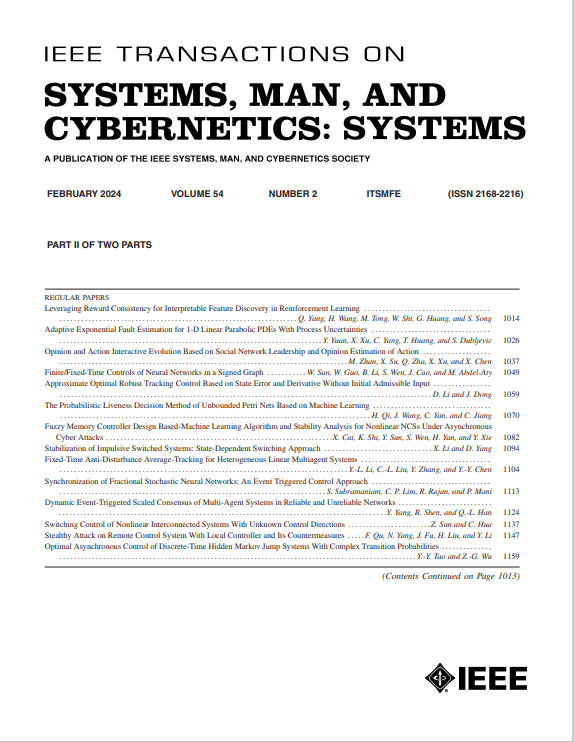多策略注入攻击下传感器网络的隐私保护分布式估计:一种混沌加密方案
IF 8.6
1区 计算机科学
Q1 AUTOMATION & CONTROL SYSTEMS
IEEE Transactions on Systems Man Cybernetics-Systems
Pub Date : 2025-04-25
DOI:10.1109/TSMC.2025.3560404
引用次数: 0
摘要
本文研究了具有混沌加密隐私保护方案和多策略注入攻击的传感器网络(SNs)上的分布式集成员状态估计问题。由于通信网络中潜在的窃听者可能会拦截传输的测量信号,因此采用混沌加密作为一种隐私保护方案,保护系统状态信息不被泄露。测量信号在传输前进行加密,在远程估计器接收后进行解密。针对随机发生、多种攻击策略组合的注入攻击,提出了一种新的攻击模型。利用矩阵不等式技术,给出了一种隐私保护方案和MIAs并存的集隶属度估计方案。随后,基于将估计误差约束在椭球范围内的充分条件,提出了在每个时间步实现最优估计性能的优化问题,并开发了计算所需估计器参数的递推算法。最后通过仿真验证了混沌加密方案下的集隶属度估计方法。本文章由计算机程序翻译,如有差异,请以英文原文为准。
Privacy-Preserving Distributed Estimation Over Sensor Networks With Multistrategy Injection Attacks: A Chaotic Encryption Scheme
This article explores the distributed set-membership state estimation problem over sensor networks (SNs) with chaotic encrypted privacy-preserving scheme and multistrategy injection attacks (MIAs). Since potential eavesdroppers in communication networks may intercept the transmitted measurement signals, chaotic encryption is adopted as a privacy-preserving scheme to protect the system state information from being revealed. The measurement signals are encrypted before transmission and decrypted upon reception by the remote estimator. A newly devised attack model is developed to characterize the injection attacks, which occur randomly and involve a combination of multiple attack strategies. By employing matrix inequality techniques, a unified set-membership estimation scheme is developed when both the privacy-preserving scheme and the MIAs coexist. Subsequently, based on the sufficient condition of constraining the estimation error within an ellipsoidal range, an optimization problem is formulated to achieve the optimal estimation performance at each time step, along with the development of a recursive algorithm for computing the required estimator parameters. Finally, simulation is provided to verify the set-membership estimation approach under the chaotic encryption scheme.
求助全文
通过发布文献求助,成功后即可免费获取论文全文。
去求助
来源期刊

IEEE Transactions on Systems Man Cybernetics-Systems
AUTOMATION & CONTROL SYSTEMS-COMPUTER SCIENCE, CYBERNETICS
CiteScore
18.50
自引率
11.50%
发文量
812
审稿时长
6 months
期刊介绍:
The IEEE Transactions on Systems, Man, and Cybernetics: Systems encompasses the fields of systems engineering, covering issue formulation, analysis, and modeling throughout the systems engineering lifecycle phases. It addresses decision-making, issue interpretation, systems management, processes, and various methods such as optimization, modeling, and simulation in the development and deployment of large systems.
 求助内容:
求助内容: 应助结果提醒方式:
应助结果提醒方式:


